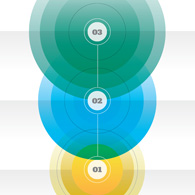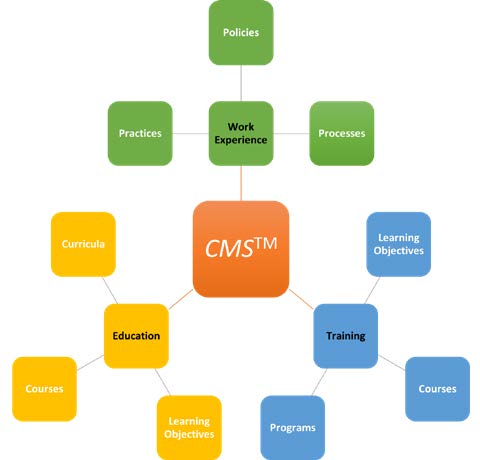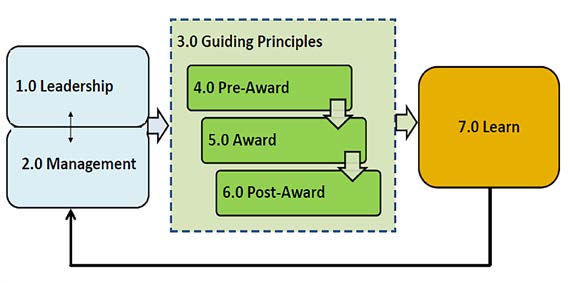 The Continuing Evolution of the Contract Management Standard
The Continuing Evolution of the Contract Management Standard
The NCMA Contract Management Standard™ recently was reaffirmed by the American National Standards Institute. Learn why this is important.
By Dr. John Wilkinson, CPCM, CFCM, Fellow
The Board of Standards Review of the American National Standards Institute (ANSI) reaffirmed NCMA’s Contract Management Standard (CMS™) as an American National Standard (ANS) on June 8, 2022.
As the sponsor of the CMS, NCMA continues to fulfill its vision to “lead in defining the standards and the body of knowledge for the contract management profession.”
Here are the answers to frequently asked questions about the CMS reaffirmation and more.
1. What is a standard and why is it needed?
ANSI defines a standard as “[a] document, established by consensus, that provides rules, guidelines, or characteristics for activities or their results.” ANSI contends that the common and repeated use of a standard will improve productivity, increase efficiency, and reduce costs.
2. What is the value of the CMS?
The value of the CMS is that it presents contract management as an integrated, whole-systems design where processes are intuitive and predictable and where potential problems are predictable and can be mitigated at their most fundamental level. The CMS provides the starting point for developing and maintaining the following:
- Contract management work experience practices, policies, and processes
- Contract management training courses and programs
- Contract management college courses and curricula
When connecting the dots among work experience, training, and education, the CMS is considered “Dot No. 1.” (See the following figure).
Figure: The CMS: Dot No. 1

3. What is the significance of ANSI reaffirmation?
ANSI reaffirmation is a third-party assessment to determine whether the process of developing the CMS demonstrates a balance of interests, lack of dominance, and right to appeal while operating in accordance with accredited ANSI requirements. To achieve this, NCMA complied with ANSI’s rigorous policies and procedures, which include:
- Standards based on consensus
- Public review and comment on draft standards
- Response to comments
- Incorporation of approved changes
- Right to appeal
4. How does an ANSI-reaffirmed CMS help professional development?
The ANSI reaffirmation process of the CMS identifies common job tasks and competencies and provides a roadmap for targeted and relevant professional development. In addition, the ANSI reaffirmation process contributes to the continual improvement of the contract management workforce and provides a bridge between formal standards and individual competence.
5. Will reaffirmation of the CMS affect the certification program?
Yes. This reaffirmation will affect the Certified Contract Management Associate (CCMA) and Certified Professional Contract Manager™ (CPCM) certification exams. The content source of the CCMA exam is the CMS. In addition, changes to the CMS drive changes to the Contract Management Body of Knowledge® (CMBOK). The CMBOK is the content source for the CPCM exam.
NCMA intends to roll out the updated CCMA exam in fall 2022. Then, there will be a transition period until December 31, 2022, during which candidates can take the exam for either Edition 2 or 3 of the CMS. The updated CMBOK will roll out in early 2023. From then to March 31, 2023, candidates can take the CPCM exam based on either Edition 6 or 7 of the CMBOK.
6. What is the problem the CMS is intended to solve?
Contract management is a very diverse and dynamic profession. Even with significant deliverables (e.g., solicitation, offer, contract, performance, and closeout), contract management terminology, practices, policies, and processes can vary greatly from one organization to another. The CMS provides stability by integrating and standardizing the common job tasks and competencies that produce significant contract management deliverables.
While organizations must establish their own practices, policies, and processes to meet their goals, the terminology used and the interpretation of practices, policies, and processes should be intuitive to all contract managers. With consistent interpretation, the likelihood of reaching agreement on matters relating to contract intent and meaning is increased. Consistent application of professional standards also enables successful contract performance across diverse industries and types of organizations.
7. Who should use the CMS?
The CMS is applicable to:
- All purchases, procurements, acquisitions – from credit card purchases to major system acquisition
- Any organization that works with any type of contract – examples include government (federal, state, and local), industry (companies selling to government or to other businesses and large, mid-sized, and small enterprises), subcon-tractors (in all tiers of the supply chain)
- Any organization developing training or education programs – government, industry, colleges, training providers (including NCMA Chapters)
- Any individual interested in developing and increasing competence – by targeting competence gaps, achieving certification, and getting meaningful results.
8. What gives NCMA the standing to develop and maintain the CMS?
In April 2018, NCMA was accredited as an Accredited Standards Developer (ASD) at the direction of the ANSI Executive Standards Council. ANSI is the only official American representative for the International Organization for Standardization (ISO).
The ANSI ASD designation enables NCMA to develop, reaffirm, and withdraw standards through its ANSI-accredited operating procedures. ANSI’s rigorous, third-party accreditation is intended to provide additional confidence and trust in NCMA standards, accreditation, and certification programs.
NCMA’s strategic plan – which includes its mission, vision, and values – completely supports the advancement and professionalism of contract management.
NCMA’s mission statement is, “Advance the profession and its nexus with other acquisition-related communities through advocacy, standards, and professional development.”
NCMA’s vision statement is, “Be the solution.”
Evidence to support NCMA’s advancement and professionalism of contract management include NCMA’s CMBOK, certification program, journal, magazine, conferences, educational events, and more. In addition, NCMA is the only professional association that supports both buyers and sellers at all levels of government and throughout all areas of industry.
Since it was founded in 1959, NCMA’s strong and continuous service to the contract management profession provides ample evidence to support NCMA’s standing to develop and maintain the CMS.
9. Why is the CMS important?
The acceptance of contract management as a profession indicates that the application of education, training, and experience will have a significant impact on individual and organizational success. The CMS aligns job tasks and competency processes to significant contract management outcomes and deliverables.
While many professions can be categorized into a single function, the contract management profession is made more complex by its division into two distinct functions: buyer and seller. It is important to know when the responsibility of one function ends and the other begins – and the points at which both functions actively engage.
The CMS presents what buyers should know, and equally, what sellers should know. Depending on the contract life cycle stage (i.e., pre-award, award, or post-award), buyers and sellers have their own distinct job tasks, competencies, and deliverables. However, at other points in the contract life cycle, these job tasks, competencies, and deliverables come together and direct inter-action between buyers and sellers occurs.
The success of buyers and sellers can be measured not only through direct interaction (e.g., negotiations or contract performance), but also when there is no direct contact (e.g., planning). Success in one function cannot occur without success in the other. Successful contract management is more likely to occur when buyers and sellers clearly understand the job tasks, competencies, and deliverables of both functions.
10. How was the CMS developed, and what gives it credibility?
The means of developing any credible standard include a Job Task Analysis (JTA) survey of interested parties, review by subject matter experts (SMEs), and a public review. In the case of the CMS:
- JTA Survey – NCMA announced the 30-day JTA survey in November 2021 by posting the announcement on its website and through an email campaign to NCMA members and nonmembers. The survey was available to anyone with access to the NCMA website.
- SME Review – Armed with the results of the JTA survey, the NCMA Standards Consensus Body (SCB) applied its subject matter expertise. With SCB consensus and approval, the CMS was made available for public review.
Public Review Period – For 45 days (February – April 2022), the announcement to solicit public comments on the CMS was posted on the ANSI and NCMA websites. In addition, NCMA issued occasional reminders of the public review through its media. The SCB responded to all comments and ANSI was copied on all the responses.
- Additional credibility is provided through an established appeal process for any objections to the CMS content or the accreditation process.
11. How were the members of the SCB selected?
The NCMA president appoints SCB members for three-year terms. The SCB is the heart of the NCMA standards program. The standards development process:
- Shall not be dominated by any single interest category, individual, or organization
- Should have a balance of interests
The SCB interest categories are buyer, seller, and general interest (academicians, consultants, researchers, regulatory authorities, and the like).
12: Who currently serves on the SCB?
Chair: Charlie Williams
Vice Chair: Penny White
Jeff Birch
Dr. Al Burman
Po Collins, CPCM
Ron Falcone, CPCM, CFCM
David Gragan, CPPO
Ted Harrison
Ruby Harvey
Dustin Pitsch
Dr. Rene Rendon, CPCM, CFCM
Martha Shepard
Tom Wells, CFCM
13. What is the intent of the CMS?
The CMS is intended to:
- Define and standardize the term “contract management” – There are lateral areas to contract management that may have differing processes and terms (e.g., acquisition management, procurement management, subcontract management, or supply management). The CMS may not be an exact fit for each of these areas, but in the absence of standards, the CMS could be adapted for use.
- Present and define the processes involved in all phases of the contract life cycle (pre-award, award, and post-award) – To successfully apply innovation to contract management processes of the buyer or seller function, a foundational understanding of the entire contract life cycle must exist for the opposite function to understand and accept the innovation.
- Develop and strengthen contract management practices, policies, and processes – A clear understanding of expected deliverables throughout the contract life cycle should lead to effective contract management practices, policies, and processes. All contract management practices, policies, and processes should provide effective use of resources (people, funds, equipment, and time).
Inspire critical thinking and learning to bring efficiency to the contract management profession – When the blending of contract management job task and competency processes is understood, an environment is created for effective critical thinking, learning, and results.
- Be a living document, with a formal change process – Unless NCMA determines that changes are needed more frequently, ANSI requires each ANS to be reaffirmed every five years using the organization’s ANSI-accredited procedures. For NCMA, changes to the CMS will be accomplished through a formal change process, which will include surveys, SME assessment, public review, and appeal rights.
14. What is the CMS not intended to do?
The CMS is not intended to:
- Become any type of rule or regulation to direct how contract management is to be performed – However, those who use the CMS as a guide to develop and maintain contract management practices, policies, and processes, training courses and programs, and college courses and curricula should find the CMS increases the likelihood they will achieve individual competence resulting in improved capability of their organizations.
- Present best practices – While the CMS is, in and of itself, a best practice, it is also designed to inspire other best practices. The CMS presents the consensus of interested parties who agree that the job tasks, competencies, and deliverables presented therein are applicable to most contracts most of the time. Consistently applying the CMS will create environments conducive to developing and executing best practices.
15. In addition to ANSI reaffirmation, what major content changes were made from Edition 2 of the CMS to Edition 3?
Major changes to the CMS include:
- Adding a scope statement – The scope statement establishes the boundaries of the CMS in its role to serve the entire community of contract management.
- Updating the definition of “contract” – This updated definition includes all legally enforceable agreements between buyers and sellers (e.g., acquisitions, grants, leases, orders, procurements, purchases, subcontracts, etc.).
- Emphasizing how contract life cycles impact each other – The cumulative effect of pre-award activities affects the performance and results of the award and post-award life cycles (and the cumulative effect of pre-award and award activities affects the performance and results of the post-award life cycle).
- Presenting how the contract life cycle phases are used in post-award activities – The contract life cycle phases (pre-award, award, and post-award) are applicable to the processes used in awarding subcontracts and contract modifications.
16. What is the difference between the CMS and the CMBOK?
The CMS is designed to present contract management as a linear system in terms of a product life cycle where there is a beginning, middle, and end to a contract (i.e., “pre-award,” “award,” and “post-award”). The CMBOK is designed to present the contract management profession as a circular system in terms of a competence development model.
The CMS competencies are the heart of the CMBOK. The CMBOK adds the competencies of “Leadership,” “Management,” and “Learn” to provide a complete overview of the profession. The CMBOK Competence System illustrates the interactive nature of the competencies (as shown in the following figure). Effectively applying the CMS will lead to improved performance and risk mitigation through intentional and targeted decision-making.
Figure: The CMBOK Competency System

In essence, to understand and apply the CMBOK, one must be able to understand and apply the CMS.
Conclusion
Standardizing a complex process such as contract management is a complex process. NCMA would like to thank all those who participated in the development of the CMS. This was truly a community effort.
The CMS is available to everyone at no cost and may be downloaded from the NCMA website.
Please submit questions or comments to [email protected]. CM.
Dr. John Wilkinson, CPCM, CFCM, Fellow, is President, tHInc, LLC.
ENDNOTES
ANSI/NCMA ASD 1-2019(R2022).
ANSI, “Frequently Asked Questions,” available at https://ansi.org.
Edition 1 of the CMS was published by NCMA in April 2016 and Edition 2 was published in April 2019.
To view NCMA’s strategic imperatives, please refer to https://www.ncmahq.org/common/Uploaded%20files/About/Governance%20Resources/ncma_strategicimperatives_py21-23_final.pdf.
https://www.ncmahq.org/Web/Web/Standards---Practices/Contract-Management-Standard-Publication.aspx.